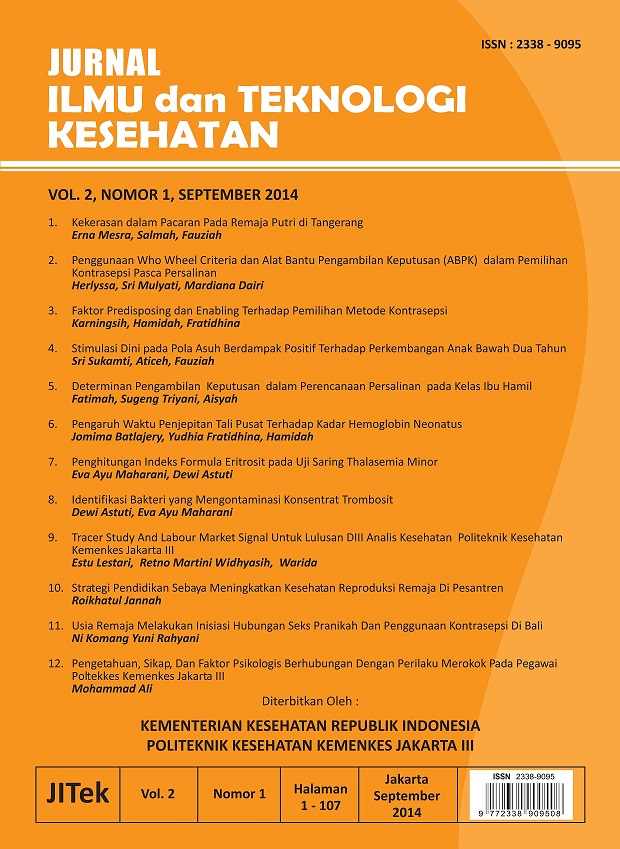Main Article Content
Abstract
Indonesian Red Cross (IRC) is an organization that received an assignment to provide blood for transfusion therapy. Blood for transfusion should free from infectious disease. Several studies have shown that viruses, bacteria and protozoa can be transmitted by transfusion. Clinical features due to bacterial contamination varies from asymptomatic, mild fever, acute sepsis, hypotension and can even cause death. Components of platelet concentrates can be a good place for the growth of Gram positive and Gram negative bacteria, because it is stored at a temperature of 20O-24OC with the addition of dextrose that can be used as an energy source for bacteria. Bacteria identification performed by culturing the component of platelet concentrates on BPA tube of Bact / ALERT. Tube with contaminated bacteria is subcultured onto blood agar media. Bacterial colonies from blood agar stained with Gram staining and further identified using API20E, API 20NE, API 20STREP, MSA media or staphilase test using reagents Staphaurex*, according to the type of bacteria detected on Gram stain. The results shown a component of platelet concentrates is contaminated by bacteria., The bacteria is Gram positive cocci clusters. MSA and staphilase test have a negative result, so it can be concluded that the bacteria that had contaminated platelet concentrates is Staphylococcus epidermidis.
Keywords
Article Details
Authors who publish with this journal agree to the following terms:
1. Authors retain copyright and grant the journal right of first publication with the work simultaneously licensed under a Creative Commons Attribution-ShareAlike License that allows others to share the work with an acknowledgment of the work's authorship and initial publication in this journal.
2. Authors are able to enter into separate, additional contractual arrangements for the non-exclusive distribution of the journal's published version of the work (e.g., post it to an institutional repository or publish it in a book), with an acknowledgment of its initial publication in this journal.
3. Authors are permitted and encouraged to post their work online (e.g., in institutional repositories or on their website) prior to and during the submission process, as it can lead to productive exchanges, as well as earlier and greater citation of published work (See The Effect of Open Access).
References
-
Andreu G., Caldani C., Morel P. 2002. Diversion of first blood volume result in a reduction of bacterial contamination for whole-blood collection. Vox Sanguinis.;3:13-16.
Benjamin, R.J. 2008. Bacterial culture of apheresis platelet products and the residual risk of sepsis. ISBT Science Series.;3 : 133-38.
Brecker, E.A.M. 2007. Effects of bacterial testing: what risks are remaining?. ISBT Science Series. 30-34.
Kiyoyama T., et al. 2009. Isopropyl Alcohol Compared with Isopropyl Alcohol plus Povidone-Iodine as Skin Preparation for Prevention of Blood Culture Contamination. Journal of Clinical Microbiology.:54-58.
Korte D.D., et al. 2008. Reduction of septic transfusion reactions related to bacteria contamination without implementing bacteria detection. ISBT Science Series.:124-32.
Martini R., et al. 2010. Bacterial contamination in platelet concentrates: identification, antimicrobial susceptibility profile and sepsis associated with the transfusion. Journal of the Brazilian Society of Tropical Medicine.; 43(6).
Murphy, M.F. 2009. Practical Transfusion Medicine. 3rd Ed. Singapore: Kitchen A.D, Barbara A.J., A John Wiley and Son Ltd.
Otto, M. 2009. Stahylococcus epidermidisthe"accidental" pathogen. NIH Public Acces. : 555-67.
Peraturan Pemerintah No. 7 tahun 2011. Pelayanan Darah. Kementrian Hukum dan Hak Asasi Manusia Republik Indonesia.
Schmidt, M., et al. 2007. Comparison of three bacterial detection methods under rourine conditions. Vox Sanguinis:15-21.
Simon, Toby, L., et al. 2009. Rossi's Principle of Transfusion Medicine. 4th Ed. USA: Park Y.A., Brecher M.E. Blackwell Publishing Ltd.
Sireis, W., et al. 2011. Extention of platelet shelf life from 4 to 5 days by implementation of a new screening strategy in Germany. Vox Sanguinis.:191- 99.
